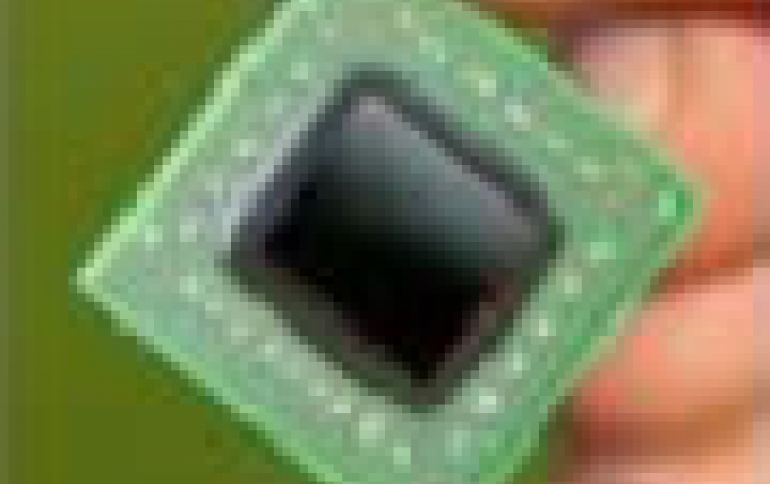
New AMD E-Series APUs Released
AMD today announced the launch of its latest AMD E-Series Accelerated Processing Unit (APU) platform, designed for essential notebook and desktop personal computers.
AMD claims that the 2012 AMD E-Series APU - formerly codenamed "Brazos 2.0," - is striking a balance between energy efficiency and innovations for high definition (HD) entertainment.
AMD is underlining the ebergy efficiecy of the new chips, saying that systems based on the 2012 AMD E-Series APU can deliver up to 11 hours of resting battery life and up to a 90 minute competitive advantage in Web browsing and online flash gaming.
AMD Steady Video technology helps remove shakes and jitters from online or other video files. The technology has plug-in support for major Web browsers along with Windows Media Player and the open source VLC player.
The new netbook platform is also offering built-in AMD Radeon HD 7000 Series graphics with DirectX 11 and DirectCompute support for gaming.
AMD Quick Stream technology prioritizes Internet bandwidth towards video stream buffering or online gaming for a smoother browsing experience.
The platform also features two SuperSpeed USB 3.0 ports, increased performance through Central Processing Unit (CPU) and Graphics Processing Unit (GPU) frequency boosts along with connectivity options for external 3D displays.

AMD has also collaborated with Microsoft to optimize the new AMD E-Series APUs for key features in Microsoft Windows 8. Optimizations for HTML5 and full support for the new Metro user interface will help accelerate new Metro-based apps developed for Microsoft's newest operating system.
AMD's E-series dual-core APUs for ultrabooks inludes the E2-1800 and the E1-1200 models. Both 40nm chips have a 18W TDP and are clocked at 1.7GHz and 1.4GHz, respectively. They support DDR3-1333/DDR3L-1333/ DDR3U-1066 memory and have 1MB L2 cache. The E2-1800 features Radaon HD 7340 GPU cores slocked at 680MHz (max) / 523MHz (base). The E1-1200 APU is using the Radeon HD7310 GPU clocked at a fixed frequency of 500MHz.
AMD's global OEMs such as Acer, Asus, HP, Lenovo, Samsung, Sony and Toshiba will offer AMD E-Series APU-based systems.
At Computex, AMD also showcased a tablet-laptop hybrid running on the company's A-series chips (Trinity - 17W). The prototype device had a 11.6-inch detachable touchscreen that could be used as a tablet when undocked from the laptop. It was made by Compal.
Customers can potentially take the Compal reference design and offer touch tablet-laptop hybrids with AMD's Trinity chips at a lower price than similar Intel's Ivy Bridge designs, AMD said.
AMD claims that its on-chip graphics performance is superior than the graphics on Ivy Bridge.
AMD is underlining the ebergy efficiecy of the new chips, saying that systems based on the 2012 AMD E-Series APU can deliver up to 11 hours of resting battery life and up to a 90 minute competitive advantage in Web browsing and online flash gaming.
AMD Steady Video technology helps remove shakes and jitters from online or other video files. The technology has plug-in support for major Web browsers along with Windows Media Player and the open source VLC player.
The new netbook platform is also offering built-in AMD Radeon HD 7000 Series graphics with DirectX 11 and DirectCompute support for gaming.
AMD Quick Stream technology prioritizes Internet bandwidth towards video stream buffering or online gaming for a smoother browsing experience.
The platform also features two SuperSpeed USB 3.0 ports, increased performance through Central Processing Unit (CPU) and Graphics Processing Unit (GPU) frequency boosts along with connectivity options for external 3D displays.

AMD has also collaborated with Microsoft to optimize the new AMD E-Series APUs for key features in Microsoft Windows 8. Optimizations for HTML5 and full support for the new Metro user interface will help accelerate new Metro-based apps developed for Microsoft's newest operating system.
AMD's E-series dual-core APUs for ultrabooks inludes the E2-1800 and the E1-1200 models. Both 40nm chips have a 18W TDP and are clocked at 1.7GHz and 1.4GHz, respectively. They support DDR3-1333/DDR3L-1333/ DDR3U-1066 memory and have 1MB L2 cache. The E2-1800 features Radaon HD 7340 GPU cores slocked at 680MHz (max) / 523MHz (base). The E1-1200 APU is using the Radeon HD7310 GPU clocked at a fixed frequency of 500MHz.
AMD's global OEMs such as Acer, Asus, HP, Lenovo, Samsung, Sony and Toshiba will offer AMD E-Series APU-based systems.
At Computex, AMD also showcased a tablet-laptop hybrid running on the company's A-series chips (Trinity - 17W). The prototype device had a 11.6-inch detachable touchscreen that could be used as a tablet when undocked from the laptop. It was made by Compal.
Customers can potentially take the Compal reference design and offer touch tablet-laptop hybrids with AMD's Trinity chips at a lower price than similar Intel's Ivy Bridge designs, AMD said.
AMD claims that its on-chip graphics performance is superior than the graphics on Ivy Bridge.





















